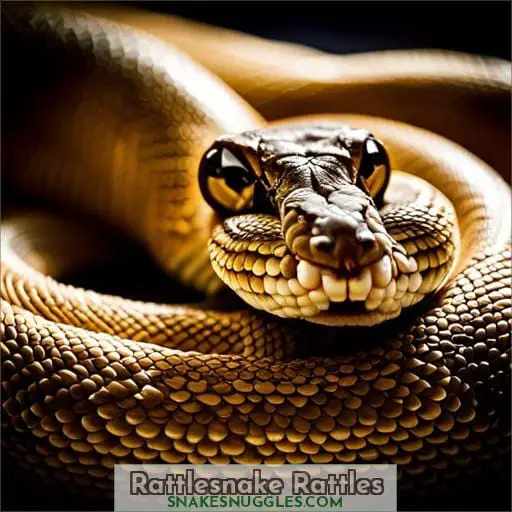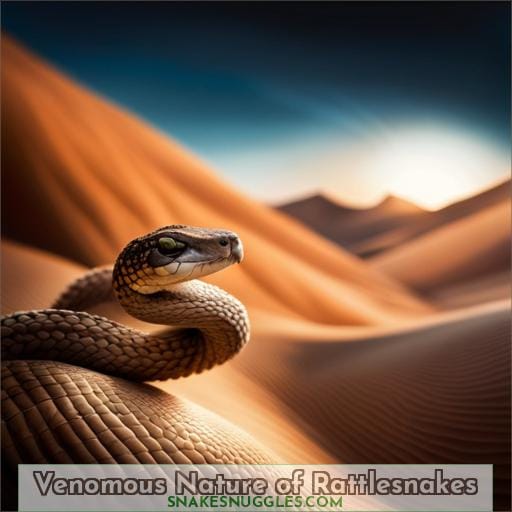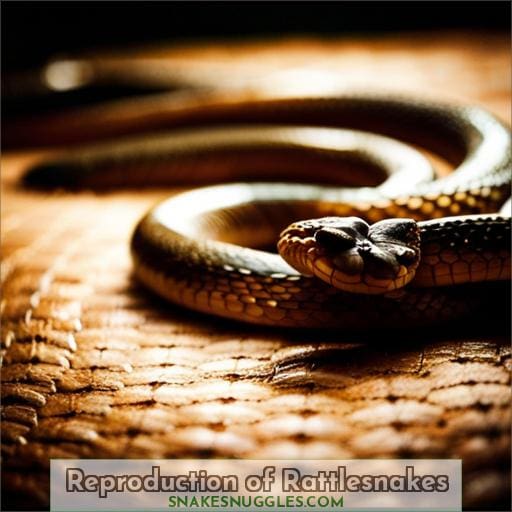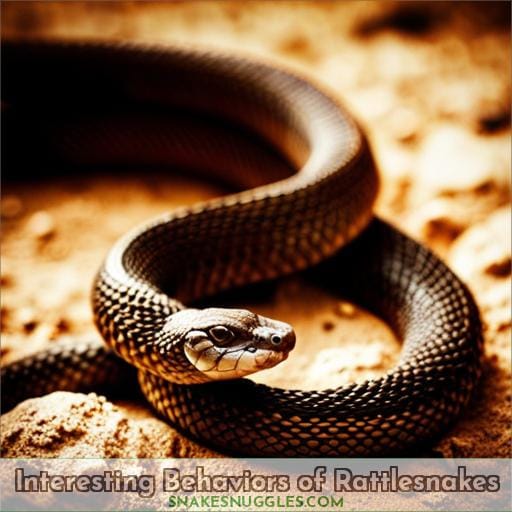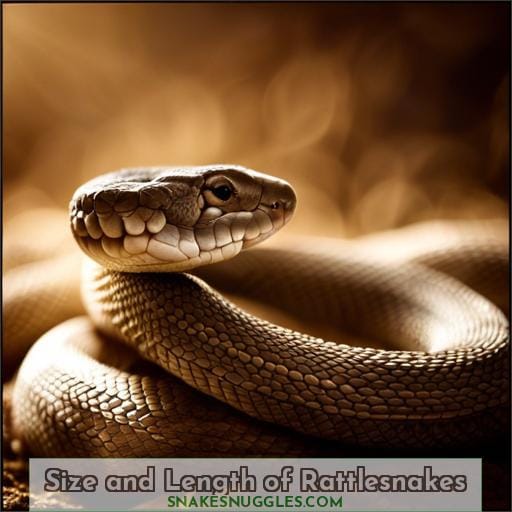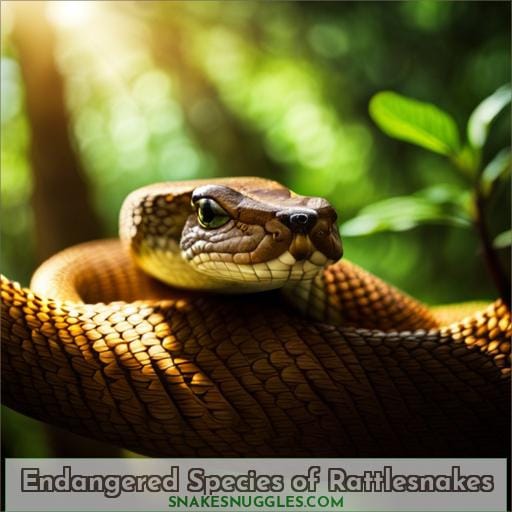This site is supported by our readers. We may earn a commission, at no cost to you, if you purchase through links.

Delve into their intricate anatomy, discover how they produce their distinctive rattling sound, and learn about the venomous nature that sets them apart.
Explore their unique reproductive strategies, predator-prey relationships, and remarkable senses and adaptations.
From intriguing behaviors to impressive size variations, these mesmerizing creatures will leave you in awe.
Prepare to expand your knowledge on these slithering serpents as we explore 27 enthralling facts about rattlesnakes – complete with captivating visuals!
Table Of Contents
- Key Takeaways
- Rattlesnake Anatomy
- Rattlesnake Rattles
- Venomous Nature of Rattlesnakes
- Reproduction of Rattlesnakes
- Predators and Prey of Rattlesnakes
- Senses and Adaptations of Rattlesnakes
- Interesting Behaviors of Rattlesnakes
- Size and Length of Rattlesnakes
- Endangered Species of Rattlesnakes
- Fun Facts About Rattlesnakes
- Frequently Asked Questions (FAQs)
- Conclusion
Key Takeaways
- Rattlesnakes have a venom delivery system with replaceable fangs and potent snake venom.
- They have sensory adaptations such as heat-sensing pits and heat-seeking pits to locate warm-blooded prey.
- Rattlesnakes use their rattles, which are modified scales, for acoustic signaling and as a warning to predators or threats.
- Reproduction and parenting in rattlesnakes involve unique mating behavior, limited parental involvement, and varying reproductive cycles.
Rattlesnake Anatomy
Take a closer look at the fascinating anatomy of a rattlesnake.
Rattlesnakes have several unique characteristics and adaptations that make them formidable predators.
One notable feature is their venomous fangs, which are hollow and used to inject venom into prey for subduing. These fangs can be replaced throughout the snake’s life as they shed their skin regularly.
Additionally, rattlesnakes possess heat-sensing pits located on each side of their face, allowing them to detect warm-blooded prey even in darkness or when hidden from view. This sensory adaptation gives them an advantage in locating potential meals during hunting expeditions.
With these predatory behaviors and anatomical adaptations combined, rattlesnakes demonstrate remarkable reproductive strategies that ensure survival in harsh environments.
Rattlesnake Rattles
You can hear a distinct sound when a rattlesnake shakes its tail, thanks to the unique feature of their rattles.
These rattles are formed by modified scales at the end of their tails and serve as an acoustic signaling mechanism.
As the snake moves its tail back and forth, these scales collide and produce a buzzing or shaking sound that’s instantly recognizable.
The cultural significance of rattlesnake rattles can’t be understated, as they’ve been associated with fear and danger in many societies around the world.
In addition to their folklore status, these venomous snakes use their distinctive rattle for an evolutionary purpose – to warn potential predators or threats of their presence before resorting to striking with venomous fangs.
Wildlife conservation efforts often focus on protecting habitats where these fascinating creatures reside so that future generations can continue marveling at this remarkable adaptation.
Venomous Nature of Rattlesnakes
Rattlesnakes possess a venomous nature, making them a formidable and potentially dangerous species. Their venomous fangs are designed to inject potent snake venom into their prey or potential threats.
One unique adaptation that sets rattlesnakes apart is the presence of heat-seeking pits located on either side of their head, which allows them to detect infrared radiation emitted by warm-blooded animals.
This helps in hunting techniques as they can accurately strike at prey even in darkness or low visibility conditions.
Defensive strikes from rattlesnakes are swift and precise, delivering an injection of venom that can have severe consequences for those unfortunate enough to be bitten.
It’s important for humans to understand the warning signals displayed by these snakes and take caution when encountering them in order to avoid environmental impact through unnecessary conflicts resulting from fear or misunderstanding.
Reproduction of Rattlesnakes
When it comes to the reproduction of rattlesnakes, one interesting aspect to note is their unique mating behavior.
The male approaches the female and engages in combat with other competing males. Once a dominant male has been established, he’ll coil around the female’s body and align his vent cloacae with hers for copulation.
Rattlesnake reproductive cycles vary depending on the species and environmental influences. Some species reproduce annually, while others may have longer intervals between breeding events.
After successful mating, female rattlesnakes undergo gestation periods ranging from several months to over a year before giving birth to live young snakes called neonates or hatchlings. Parental involvement is minimal after birth as there’s no maternal care provided by adult rattlesnakes towards their offspring.
Offspring characteristics also differ between species but generally exhibit similar traits such as miniature versions of adults with fully functional venom glands at birth.
Overall, understanding the intricacies of rattlesnake reproduction provides insight into these fascinating creatures’ life cycle adaptation strategies for survival amidst various environmental challenges they face.
Predators and Prey of Rattlesnakes
To survive in their natural habitats, rattlesnakes rely on a diverse range of prey species for sustenance. As predators, rattlesnakes play an essential role in maintaining ecological balance by controlling the populations of their prey.
These venomous snakes employ various strategies to detect and capture their food. With highly developed heat-sensing pits and keen sense of smell, they can locate potential prey from a distance. Rattlesnakes are ambush predators that patiently wait for unsuspecting animals to come within striking distance before launching quick and accurate attacks with their venomous fangs.
Their predatory patterns often involve targeting small mammals such as mice, voles, shrews, chipmunks, squirrels or occasionally birds that frequent the same habitat as them. After capturing their prey using defensive strikes infused with hemolytic venom to subdue it quickly without wasting energy or risking injury themselves; they swallow it whole due to lack of limbs.
This delicate balance between predator and prey is crucial not only for the survival of individual rattlesnake populations but also for maintaining overall ecosystem health through population control measures while minimizing environmental impact.
Senses and Adaptations of Rattlesnakes
Moving on from the discussion of predators and prey, let’s delve into the fascinating senses and adaptations that make rattlesnakes such formidable creatures.
Rattlesnakes possess a remarkable ability to perceive thermal radiation, allowing them to detect even the slightest differences in temperature. This thermal perception enables them to locate warm-blooded prey with precision, even in total darkness.
In addition to their exceptional heat-sensing capabilities, rattlesnakes also have highly developed environmental awareness. They’re adept at navigating through complex terrains with their keen sense of spatial orientation and body awareness.
When it comes to hunting strategies, rattlesnakes employ a patient ambush technique by remaining motionless for extended periods until unsuspecting prey ventures within striking distance. Their venomous bite immobilizes or kills their victims swiftly before they’re consumed whole.
To defend themselves against potential threats or perceived danger, these snakes rely on several defensive tactics including warning displays such as shaking their signature rattle as a clear auditory signal for intruders.
These behavioral adaptations coupled with an array of sensory abilities allow these incredible reptiles not just survival but mastery over their environment.
Interesting Behaviors of Rattlesnakes
Watch out for the fascinating behaviors of rattlesnakes as they exhibit a variety of intriguing actions to defend themselves and capture their prey.
- Hibernation Rituals: Rattlesnakes hibernate in large groups called hibernacula to conserve energy during the cold winter months.
- Territorial Behavior: Rattlesnakes are highly territorial and mark their territory using scent glands located on their chin.
- Social Interactions: While generally solitary, rattlesnakes may congregate in communal dens during hibernation or mate selection periods.
These behaviors play crucial roles in the survival and reproductive success of these remarkable creatures. From defending territories through intimidation with their rattling tail, to performing intricate mating dances that showcase strength and dominance, each behavior is finely tuned over generations by natural selection.
Additionally, when it comes to preying upon other animals, snakes employ various strategies such as ambush hunting or tracking movements through heat-sensing pits. The study of these interesting behaviors allows us a glimpse into the complex lives led by these mesmerizing serpents.
Size and Length of Rattlesnakes
Moving on from the interesting behaviors of rattlesnakes, let’s now delve into the fascinating world of their size and length. Rattlesnakes display a wide range of sizes, with variations influenced by growth patterns, environmental factors, geographic locations, age-related changes, and even comparative species.
To give you an idea of these differences in a visually appealing manner:
| Species | Average Length (inches) |
|---|---|
| Diamondback Rattlesnake | 72-96 |
| Eastern Massasauga | 18-30 |
| Sidewinder | 20-30 |
As we can see from this table, there’s significant variation among different rattlesnake species. Factors such as den selection during winter months, specifically seeking out protected hibernacula like caves or rock piles where do snakes go in the winter, or changing seasons can also impact snake behavior which further influences their size and length.
It’s important to note that these measurements are averages; individual snakes may exceed or fall short of these ranges depending on various factors.
Endangered Species of Rattlesnakes
Now let’s turn our attention to the endangered species of rattlesnakes, exploring their unique challenges and conservation efforts.
- Conservation Efforts:
- Organizations are working to protect and restore the habitat of endangered rattlesnake species.
- Population monitoring programs help track the population size and distribution of these snakes.
- Captive breeding programs aim to increase the numbers of endangered rattlesnakes in controlled environments.
- Educational campaigns raise awareness about the importance of conserving these iconic reptiles.
These initiatives play a crucial role in safeguarding not only individual snake populations but also preserving biodiversity. By restoring habitats, monitoring populations, breeding snakes in captivity, and educating communities about their significance, we can work towards ensuring that future generations will continue witnessing these fascinating creatures.
Through such efforts, we strive for a world where humans coexist harmoniously with nature while appreciating its beauty and diversity.
Fun Facts About Rattlesnakes
Get ready to discover some fun and fascinating facts about rattlesnakes! These amazing creatures have many unique characteristics that make them truly remarkable.
Check out the table below for a visual representation of these interesting facts:
| Fun Facts About Rattlesnakes |
|---|
| Behavioral Insights |
| Rattlesnakes use their rattles as a warning signal when they feel threatened. |
| They also engage in combat dances where males wrestle each other to establish dominance. |
| Ecological Role |
| As predators, rattlesnakes play an important role in controlling rodent populations, which helps maintain ecosystem balance. |
| Cultural Significance |
| Rattlesnake venom has been used for medical research and even has potential applications in developing anti-venom treatments. |
Conservation Efforts
Conservation efforts are ongoing to protect endangered species like the timber rattlesnake from habitat loss and illegal trade.
Misconceptions Clarified
Contrary to popular belief, not all snakes lay eggs; some species of rattlesnakes give live birth. Additionally, while forked tongues may seem scary or aggressive, they actually help snakes gather scent particles from their environment.
Frequently Asked Questions (FAQs)
How many different species of rattlesnakes are there?
There are approximately 36 different species of rattlesnakes.
Each species has its own unique characteristics, habitats, and behaviors.
These fascinating creatures play an important role in ecosystems and command respect with their venomous bites.
What is the average lifespan of a rattlesnake?
The average lifespan of a rattlesnake varies depending on factors such as species, habitat, and individual circumstances.
Generally, they can live for 10-25 years in the wild. However, some individuals have been known to live up to 30 years or more.
How do rattlesnakes find their prey?
Rattlesnakes, with their heat-sensing pits and keen sense of smell, possess remarkable abilities to locate prey.
Through a combination of sensory adaptations and strategic hunting techniques, these venomous predators strike fear into the hearts of their unsuspecting victims.
Do rattlesnakes have any natural predators?
Rattlesnakes have natural predators, including:
- Birds of prey like hawks and owls.
- Mammals such as coyotes and foxes.
These animals play a crucial role in maintaining the balance of ecosystems by controlling rattlesnake populations.
Can rattlesnakes swim?
Rattlesnakes are adept swimmers, allowing them to navigate through bodies of water with ease.
They use their muscular bodies and flattened tails as propulsion mechanisms, enabling graceful movement in aquatic environments.
Conclusion
To conclude, rattlesnakes are truly fascinating creatures. With their intricate anatomy, distinctive rattling sound, and venomous nature, they captivate our attention. Their unique reproductive strategies, predator-prey relationships, and remarkable senses and adaptations further showcase their adaptability and survival skills.
From their interesting behaviors to impressive size variations, rattlesnakes never cease to amaze us. As we delve into the world of these slithering serpents, we gain a deeper understanding and appreciation for the beauty and complexity of nature.
Explore these 27 enthralling facts about rattlesnakes and let their mesmerizing presence leave you in awe.


